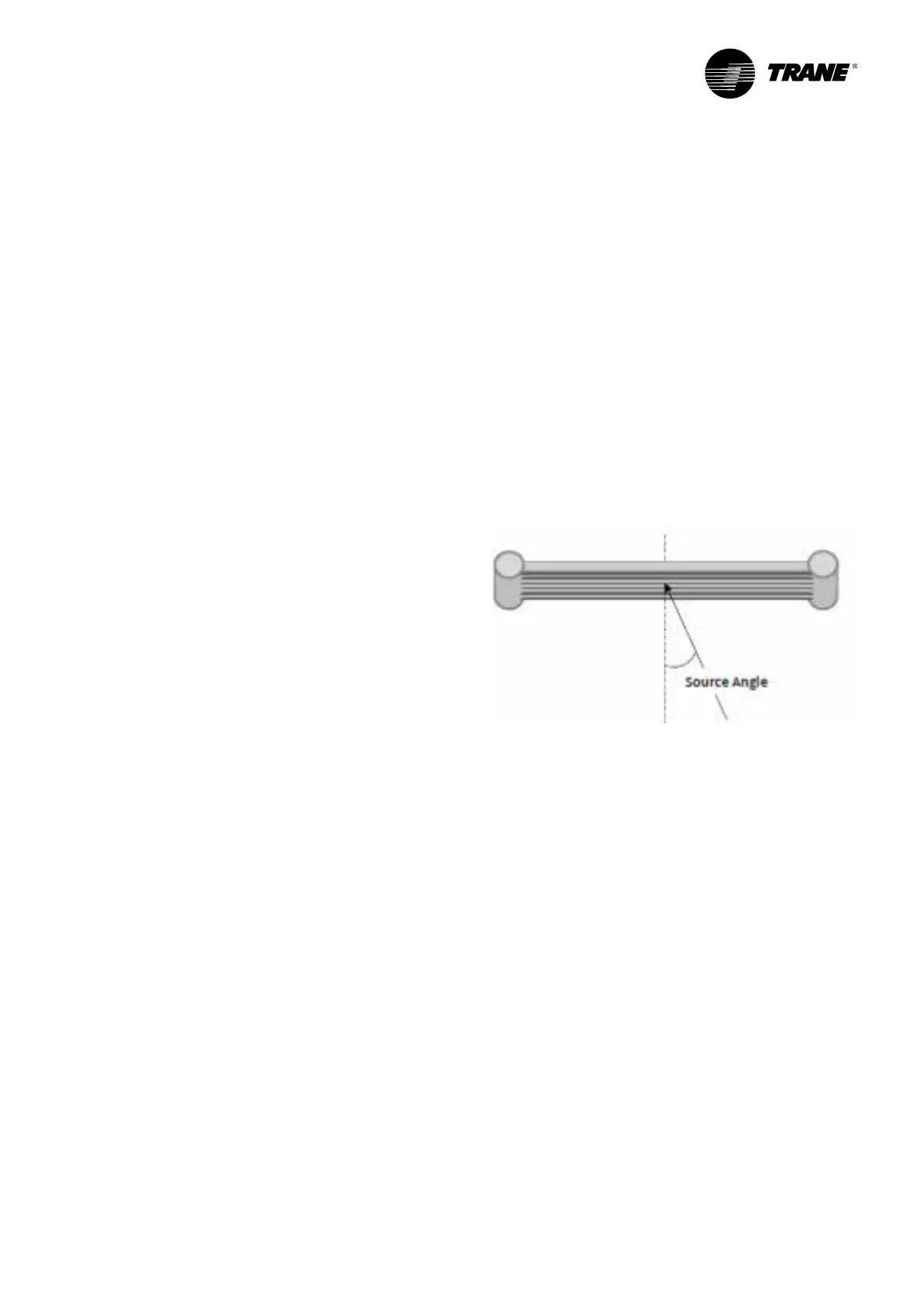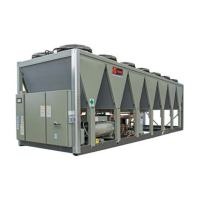RLC-SVX19G-GB
171
11UNT-PRC002-GB
Sound power levels
Discharge
Measurement conditions:
Measurements taken in a room adjacent to the room containing the FWD, at the outlet of the rectangular duct (1.5 m
long) fixed to its discharge opening.
Fan Power level in dB(A), per Hz frequency band Overall power
Unit speed 125 250 500 1000 2000 4000 8000 dB(A)
1 55 50 42 37 37 31 30 46
FWD 08 2 57 54 47 40 30 38 40 50
3 58 57 50 42 32 40 43 53
1 57 51 45 42 34 33 28 48
FWD 10 2 58 54 48 45 38 39 35 51
3 60 58 50 48 40 42 39 54
1 57 51 45 42 34 33 28 48
FWD 12 2 58 54 48 45 38 39 35 51
3 60 58 50 48 40 42 39 54
1 56 62 50 48 39 38 36 56
FWD 14 2 61 66 55 53 47 46 45 60
3 63 69 58 56 50 50 49 63
1 57 63 51 49 40 39 37 57
FWD 20 2 61 66 55 53 47 46 45 60
3 63 69 58 56 50 50 49 63
Intake
Measurement conditions:
Measurements taken at the horizontal air intake.
Fan Power level in dB(A), per Hz frequency band Overall power
Unit speed 125 250 500 1000 2000 4000 8000 dB(A)
1 56 55 55 53 46 45 42 57
FWD 08 2 63 62 60 60 53 53 53 64
3 66 65 63 62 56 55 57 67
1 62 58 55 58 51 48 44 61
FWD 10 2 66 63 60 62 56 55 52 66
3 70 67 63 65 59 59 57 69
1 62 58 55 58 51 48 44 61
FWD 12 2 66 63 60 62 56 55 52 66
3 70 67 63 65 59 59 57 69
1 66 65 65 65 57 50 46 68
FWD 14 2 73 72 69 71 64 59 57 74
3 78 76 73 75 69 64 63 78
1 68 72 64 64 56 52 50 69
FWD 20 2 76 76 68 71 65 61 61 75
3 78 79 71 74 69 66 66 78
Condenser Coils MCHE Maintenance
Cleaning Procedures
• It is mandatory to clean regularly the coils for a proper
unit operation. Eliminate pollution and other residual
material help to extend the life of the coils and the unit
CAUTION! Equipment Damage! Do not use coil cleaning
agents to clean uncoated RTAF coils. Use clean water
only. Use of coil cleaning agents on uncoated RTAF coils
could cause damage to coils.
• Regular coil maintenance, including annual cleaning-
enhances the unit’s operating efficiency by minimizing
compressor head pressure and amperage draw. The
condenser coil should be cleaned at least once each
quarter or more if the unit is located in a “dirty” or
corrosive environment. Unless it is the Trane cleaner
part reference CHM014E cleaning with cleansers or
detergents is strongly discouraged due to the all-
aluminum construction; straight water should prove
sufficient.
Important: Only in extreme cases should any type of
chemical cleaner or detergent be used on microchannel
coils. If it becomes absolutely necessary because water
alone did not clean the coil, specify a cleaner that is:
• A is pH neutral cleaner.
• An alkaline cleaner that is no higher than 8 on the
pH scale.
• An acidic cleaner that is no lower than 6 on the
pH scale.
• Does not contain any hydrofluoric acids.
Be sure to follow the instructions provided with any
cleaner chosen. Keep in mind that it is still MANDATORY
that the coils are thoroughly rinsed with water after the
application of the cleaner even if the instructions specify
a “No Rinse” cleaner. Cleaners or detergents that are
left on the coil due to improper rinsing will significantly
increase the possibility of corrosion damage on the
microchannel coil.
Note: Quarterly cleaning is essential to extend the life
of an E-coated coil and is required to maintain warranty
coverage. Failure to clean an E-coated coil will void
the warranty and may result in reduced effi ciency and
durability in the environment.
WARNING! Hazardous Voltage!
Disconnect all electric power, including remote
disconnects before servicing. Follow proper lockout/
tagout procedures to ensure the power cannot be
inadvertently energized. Failure to disconnect power
before servicing could result in death or serious injury.
1. Disconnect Power to the unit.
2. Wear proper personal protection equipment such as
a face shield, gloves and waterproof clothing.
3. Remove enough panels from the unit to gain safe
access to the microchannel coil.
Note: It is better to clean the coil from the opposite
direction of normal air flow (inside of unit out) because
this allows the debris to be pushed out rather than
forced further into the coil.
4. Use a soft brush or vacuum to remove base debris or
surface loaded fibers from both sides of the coil.
5. Using a sprayer and water ONLY, clean the coil
following the guidelines below.
a. Sprayer nozzle pressure should not exceed
40 bars.
b. The maximum source angle should not exceed
25 degrees (Figure 22) to the face of the
coil. For best results spray the microchannel
perpendicular to face of the coil.
c. Spray nozzle should be approximately 5 to 10 cm
from the coil surface.
d. Use at least a 15º fan type of spray nozzle.
Figure 40 – Sprayer source angle
To avoid damage from the spray wand contacting the
coil, make sure the 90º attachment does not come in
contact with the tube and fin as abrasion to the coil
could result.
Repair/Replacement of
Microchannel Coil
Microchannel coils are considerably more robust in
design than tube and fin condenser coils, however they
are not indestructible. When damage or a leak occurs in
the field, it is possible to temporarily repair the coil until
another coil can be ordered.
If the leak is found to be within the tube area of the coil,
a field repair kit (KIT16112) is available through your
local Trane parts center. Because of the all-aluminum
construction and aluminum’s high thermal expansion
rate, a leak located at or on the header assembly cannot
be repaired.
